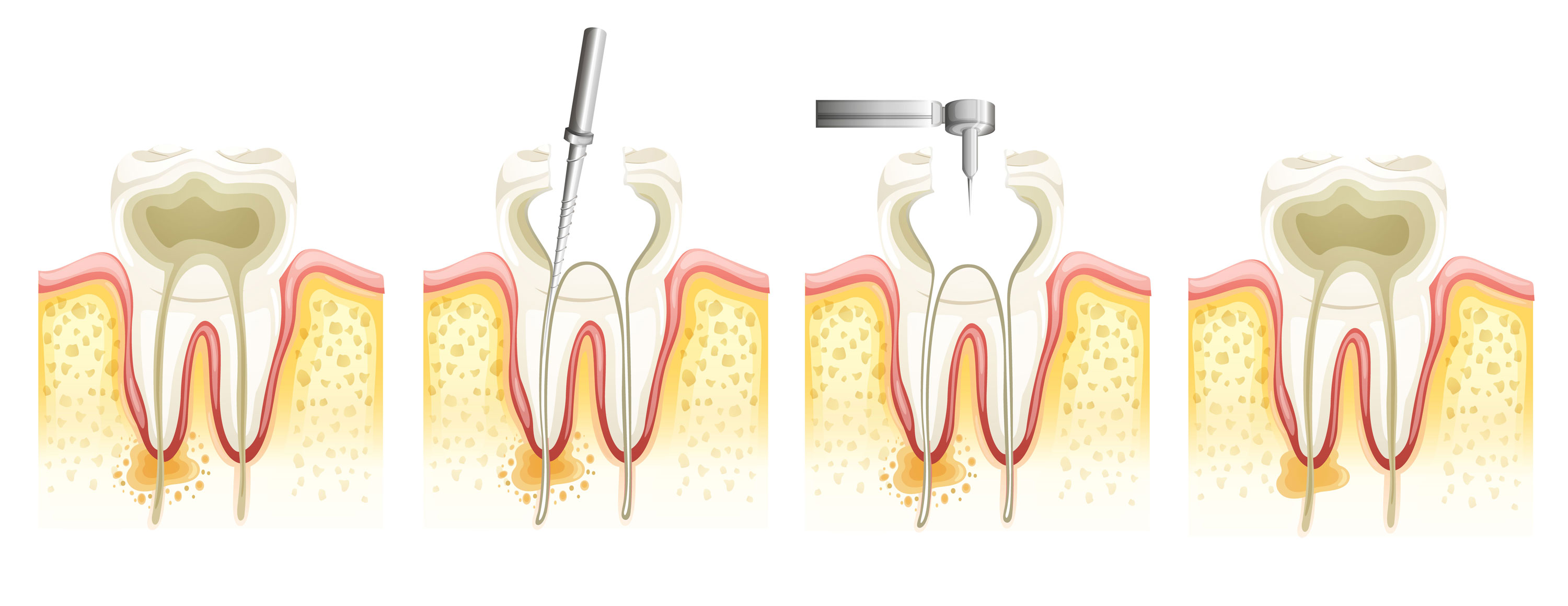This is the human tooth like
It is important that we understand the structure of the human tooth in order to learn the procedure of the root treatment. The inner part of the tooth contains the pulpa under the tooth enamel and the layer of dentin. The pulpa reaches to the crown part of the tooth from the end of the root and contains veins and nerves which keep the tooth alive and help its development.
The bone tissue which surrounds the tooth is able to keep the tooth in the mandible even without the pulpa for a long time after the endodontia.
The endodontia – or tooth root treatment – means the treatment of the inner part of the tooth. This is the most frequent procedure the dentists perform in order to keep a tooth.
When do we need endodontia?
If the inner part of the tooth gets inflammed we surely need endodontia. With its help a tooth or root damaged on account of an incident or caries and moreover the pain or chewing sensivity can be eased or relieved. This treatment is also able to prevent further infections or focal infections or other illnesses.
Our teeth have not only blood circulation and metabolisme but contain nerve fibres, too. The nerve and vein system may get damaged because of injuries, e.g. caries, shock, break of the tooth crown. After an occurrence bacterii mag get into the inside of the tooth and cause inflammation. If the inflammed pulpa gets no treatment it may cause further sensitivity, pain and inflammation.
In what cases you have to visit our dentistry?
- if you feel a sharp, acute tooth pain;
- if you feel a dull pain increassing after laying down when going to bed;
- if you feel an ever increasing pain in the tooth from warm temperature;
- if you feel pain when chewing or when the tooth area is pressed;
- if the tooth got a hit or was involved in an incident;
- if your tooth has remarkably discolored;.
- if you feel a days long, strong pain with a strong tumescence in and around the tooth area, without treatment.
What is the endodontia treatment in the ArtDent clinic like?
Our dentists remove the nerves and the veins during endodontia. The procedure, in spite of the general beliefs, does not cause pains because it is performed in a local anaesthetization The patient will be relieved of he pain after the treatment, though the tooth can be still sensible for some days. During endodontia the dentist cleans the root canal with special tools and a canal cleaning instrument: this procedure shortens the time needed and less roentgen pictures and the root filling itself will be quicker and more correct.
In ArtDent Dentistry Clinic the treatment is performed with the most up to date German computer system.
It is not always possible to perform the treatment in a single occasion. In this case our dentist puts a provisional medicine filling in the tooth then the treatment will follow later in our dentistry.
If the tooth does not cause complaints after the treatment then the permament root filling can be performed. In our clinic we use the most up to date German root filling method.
After the dentist performed the root filling the tooth can be repaired with an aesthetic filling, an aesthetic inlay or a crown.

Is it possible to perform an endodontia in every tooth?
There are cases when it is not possible to perform the endodontia because of anatomic or other causes. In this occasion the dentist suggests another oral operation, a resectio. (gyökércsúcs- eltávolítás (szolgáltatás/szájsebészet/gyökércsúcs-eltávolítás aloldalra vigyen)
Those teeth of which the roots can not be treated this way should not be kept because they get inflamed and causes further local infections. These infections cause loss of hair, joint and skin problems, eye and heart sickness or inflammation in the facial cavity and their removal is of utmost importance.
The removal of these teeth are removed by an oral operation. This intervention should always be performed by an oral surgeon because the removal of lifeless teeth is a more complicated task. The lost teeth and roots should generally be replaced. The implantation (szolgáltatások/fogbeültetés aloldara vigyen) and the tooth bridges (szolgáltatás/fogpótlás/híd aloldalra vigyen) are the solution.
What the patient should do after an endodontia
In most cases after endodontia the tooth will be painless. There is nothing special to do with it but sometimes the tooth may stay sensitive for one or two days or some sensitivity is to be felt when masticating but these can not be sharp pains. The gingival area around the inflamed tooth can also be inflamed and it needs some days for perfect healing. Sometimes a referred pain can also be felt but this also disappear in the natural way.
The tooth after endodontia may function normally for a long time but it may not be as strong as an intact one. We suggest our patients to visit our dentistry once a year to have the tooth involved checked by an X-ray picture.
If after endodontia the tooth involved seems discolored our dentists may help with whitening the inner part of the tooth.
Visit us for a free, no obligation consultation, (szolgáltatás/konzultáció aloldalra vigyen) and our learned dentists tell you every information of your dental problems, using our up to date diagnostic instruments.
Testimonials
The first step to a healthy and an aesthetical smile
Send us your complete finding, dental x-ray and write us the exact problem you’re experiencing as detailed as possible in order to speed up the diagnosis. After receiveing your e-mail we provide you a free dental quote of the possible treatments. Of course, the information you submit is treated with the greatest discretion. We will review the submitted material , and after a free online consultation we prepare a preliminary treatment plan for you according to your x-ray.


